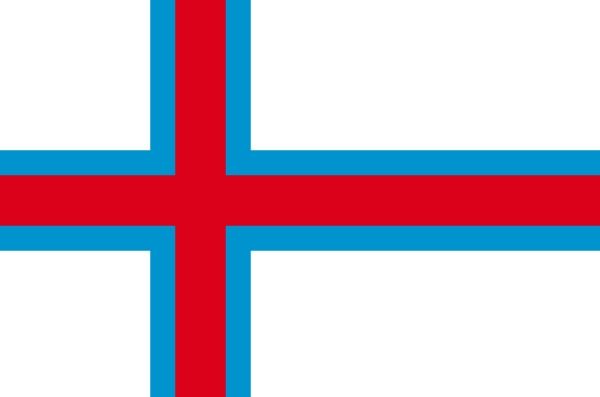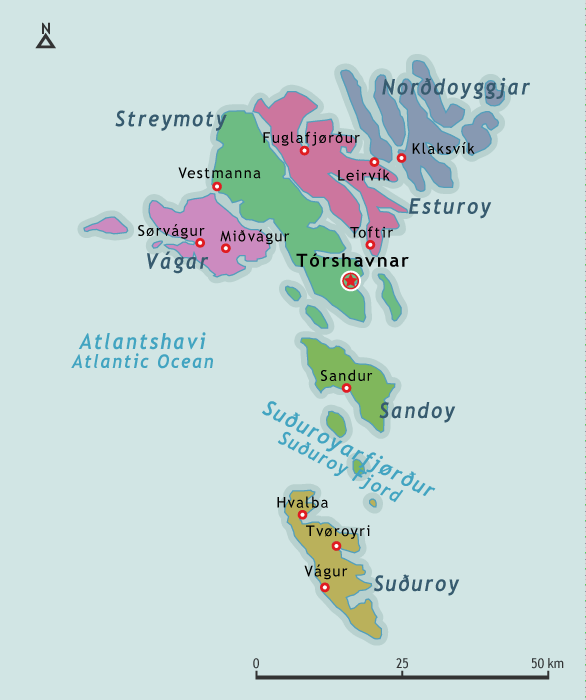The Faroe Islands, insurmountable archipelago of the Atlantic

Subjected to the harsh climate of the North Atlantic, the Faroe Islands appear as a small dot on the map between Scotland, Norway and Iceland. Despite their size, the Faroe Islands are organised into a quasi-state and have their own institutions. The Faroese people work hard to control their destiny by developing a strong sense of belonging and a language spoken by the entire population of the island.

The Faroese people, distant descendants of the Vikings, have always defended their culture and their independence while struggling for survival on inhospitable land originally populated by sea birds and sheep. The Faroe Islands are self-governed according to the old Scandinavian practices of electing a representative assembly. The Norwegian king was initially recognised as sovereign and by an accident in history the Faroese are today under the control of the Danish monarchy, which leaves them to govern themselves.
Conflicts linked to fishing have long monopolised the attention of the Faroese who enjoy a rich fishing source. Relations with their neighbours today, however, are more or less peaceful.
Because their geographical distance places them far away from the central power and a sense of consensus, the Faroe Islands have developed great legal expertise. Elected by the people since 1948, parliament (Løgting) is officially recognised as a legislative authority. For example, the Faroe Islands are not part of the European Union and may in some respects conduct their own foreign policy in some areas. The question of independence arises now in a more meaningful manner and could make its reappearance in debates in the coming years.

Identity card

| Name | Føroyar | Faroese Færøerne | Danish (Faroe) |
| Population | 52,337 inhab. (2020) |
| Area | 1,399 km² |
| Languages | Føroysk | Faroese Dansk | Danish (official) |
| Number of native speakers | 72,000 | Faroese |
| State of guardianship | Denmark |
| Official status | Autonomous island belonging to Denmark |
| Capital | Tórshavn |
| Historic religion | Lutheran and Calvinist |
| Flag | Merkið | Faroese (The Emblem) |
| Anthem | Tú alfagra land mítt | Faroese (You, my magnificent country) |
| Motto | None |

Timeline

- 9th century • Introduction of Scandinavian people and those from the British Isles.
- 11th century • Recognition of Christianity by the Løgting Assembly.
- 1270 (circa) • Treaty with the king of Norway recognising his supremacy on the island while retaining the right to selfgovernment.
- 1380 • Union of Norway and Denmark, little by little the administrative capital becomes Copenhagen.
- 1814 • Danish rule. The Løgting is not convened for 50 years.
- 1856 • The Løgting meets and is able to take legislative action.
- 1948 • After the de facto independence during the war and a referendum in favour of seccession, the Faroe Islands retains extensive autonomy.
- 2004 • All the political parties agree to a constitutional process to reduce the influence of Danish power.

Brief history

After the Second World War, the Faroese were recognised quickly for their efforts during this difficult period. Indeed, the allies settled there so as to prevent the Germans setting up a base. In 1948, the Faroese organised a referendum for independence. The people opted for this solution but, following parliamentary elections, the choice of a trade solution with Denmark was finally chosen in order to achieve a gradual independence. Since this period, the Faroe islands have remained divided between loyalty to the fact that Denmark provides large subsidies and a desire for instant secession. This ambivalence was observed in the drafting of the new constitution in 2004, where Danish subsidies were renounced while gradually the promised independence was reached, whilst also respecting the shared feelings of the public on this issue.

Geography

The Faroe Islands are made up of 18 volcanic islands between the Shetland Islands (Scotland), Iceland and Norway. The population is located on the six biggest islands. Their privileged position in the North Atlantic offers them unrivalled fishing resources. The seabed contains many minerals and possibly oil. The Faroe Islands benefit from a temperate climate thanks to the warm currents of the Atlantic. Thus the vegetation is essentially made up of grass herbs. The thermal contrasts due to low pressure create a pleasant ambience, inspiring artists of all genres. The housing consists of little coloured houses located on the coast and notably in Tórshavn (the capital) which takes its name from the ancient god of thunder “Thor”, and the word “havn”, harbour.



Politics now

The Løgting, parliament of the Faroe Islands, has a very strong autonomy, to which all political parties are committed. Depending on the political circumstances, they often advocate cutting all links with Denmark. Economic and social politics equally divide the parties, creating a very diverse political landscape, even if non-adherance to the European Union remains unanimous. The system of “Scandinavian” social protection is also one of the big cohesive factors for the Faroe Islands. These numerous lines of parliamentary political fracture often create unpredictable coalitions, without real party logic.
Principal Faroese parties
- Tjóðveldi / Republican Party (Socialist separatist)
- Hin føroyski fólkaflokkurin – radikalt sjálvstýri / Faroese People’s Party – Radical Self-Government (Conservative separatist)
- Framsókn / Progress (Liberal separatist)
- Miðflokkurin / Centre Party (Christian democracy regionalism)
- Sjálvstýri / Self-Government (Autonomism)

